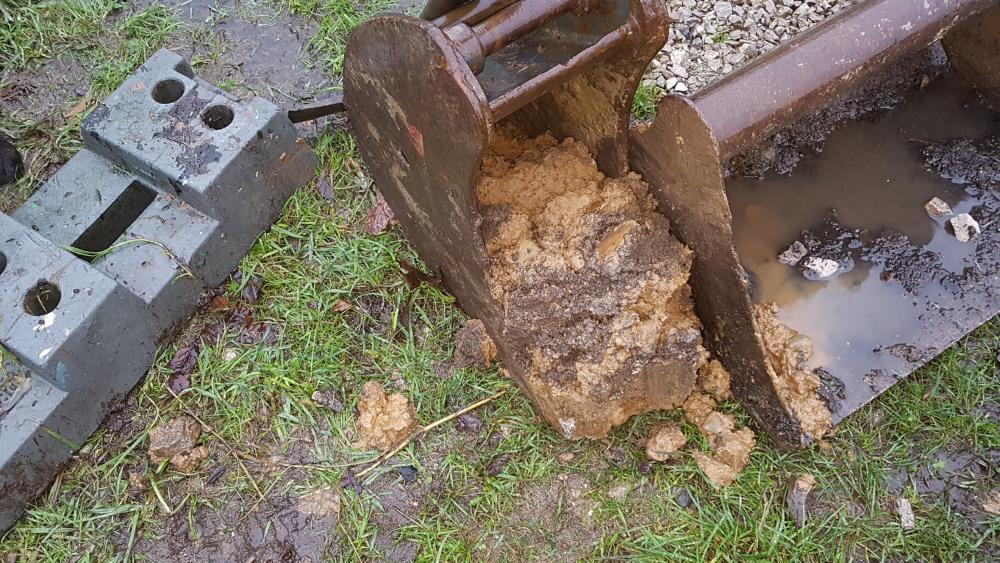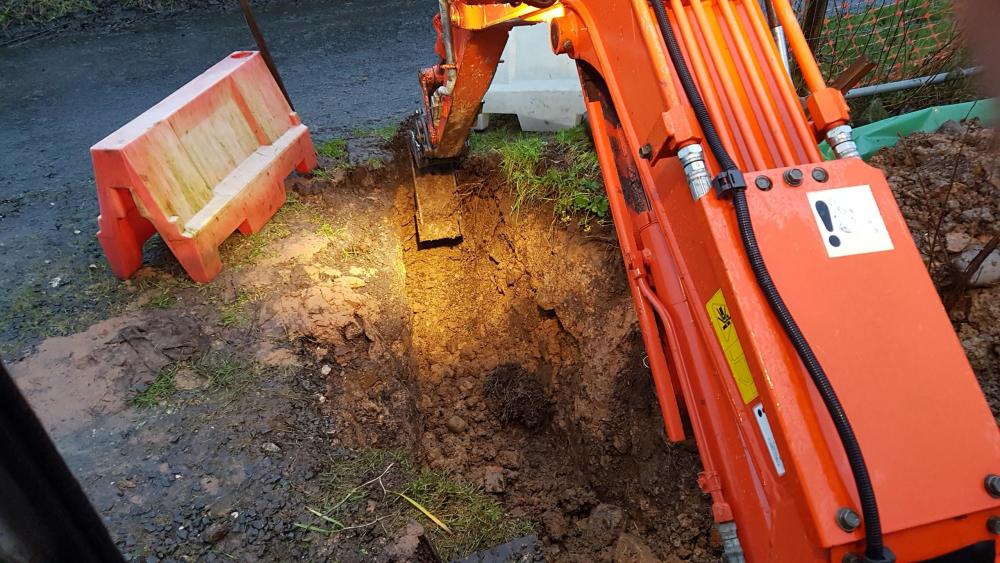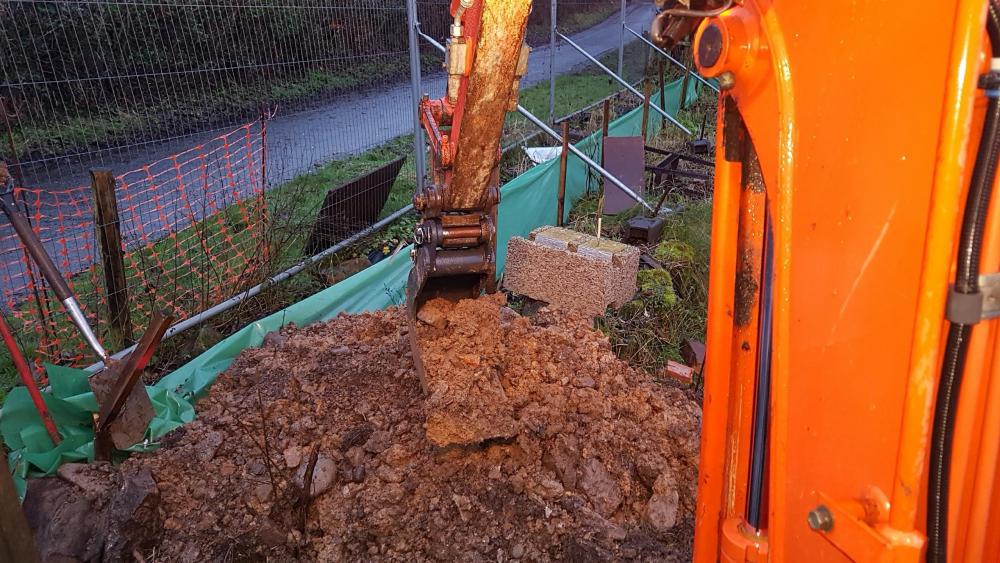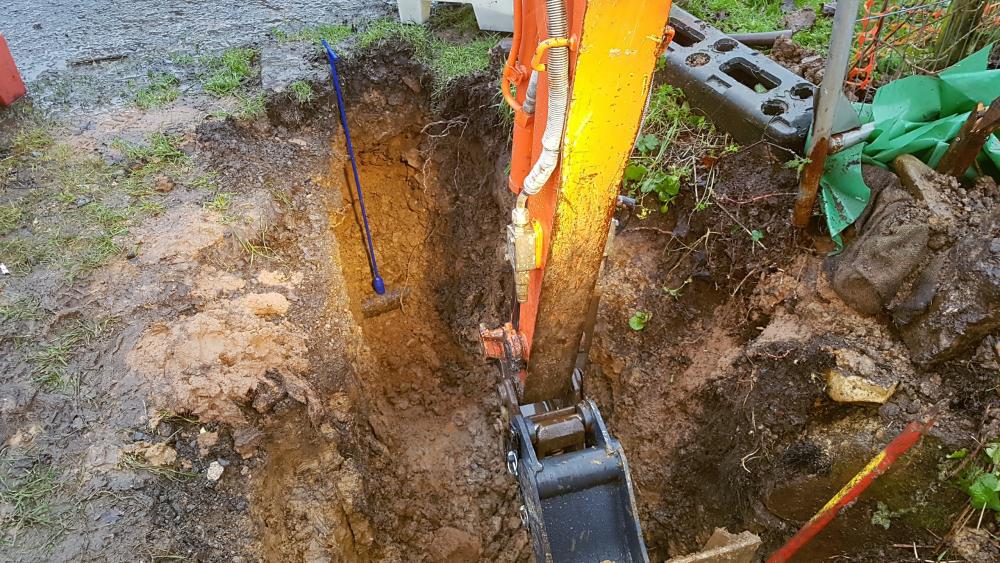Search the Community
Showing results for tags 'clay'.
-
Good morning all, Thank you for allowing me to take part in this forum. Just to introduce myself, my name is Eric and I'm a newbuild homeowner. The reason why I am writing on this forum is to seek guidance from other more knowledgeable users in regards to landscaping. I am based in East Devon, in an area which is predominantly very clayey. The land where my development was constructed used to be farmland, and so I assume that it is quite fertile. Anyhow, I think I'll just start off describing my concerns in chronological order: At reservation stage, the developer provided us with a standard specification setting out finishes, colours, etc. One of the items in the spec was the finish to the garden areas (back garden and a strip out front along the facade). The spec stated that the ground would be finished with a 150mm thick layer of topsoil. I was quite glad that this was the case, as my concern was that the underlying clay would challenge the garden's ability to drain rainwater. Fast forward to completion, we get the keys to the house and to my surprise, the garden was topped off with site-won material, i.e. clay. In addition, the plot was plagued with stones the size of fist. To me that didn't look like topsoil... However, the next question I asked myself was: what is topsoil anyway? Doing some research, I found that there is a British Standard entitled "Specification for topsoil" (BS 3882:2015 - in case you're interested). This standard sets out the requirements for a soil to be classified as topsoil. One of these requirements is that the "maximum coarse fragment content" greater than 50mm has to be 0%. In other words, stones greater than 50mm in diameter should not be present at all, which is something that my garden clearly doesn't meet. I have gone back to the developer with this (it's been more than a month already) and they are still figuring out what to respond. I am not trying to be picky here, but I've paid a large sum of money for my new home and I will always try to make sure that I obtain a quality product that meets the minimum standards. I should add that the NHBC standards specify that gardens should be finished with a minimum of 100mm of topsoil. NB: my neighbours have placed a ver thin film of topsoil on their garden after picking out the majority of big stones. They then planted some grass seed and it's growing well. However, I think as soon as they start transiting the grass, the clay will compact and it'll become boggy with rain, which will eventually compromise the health of the grass, etc. I would be grateful if others could share their views/experiences on the matter, as I'm not sure if I'm making this a bigger issue than what it really is? Thank you very much, Eric
- 13 replies
-
- clay
- landscaping
-
(and 3 more)
Tagged with:
-
We are just about to begin the planning application for our new house, had a positive pre app response from senior planner on design so fingers crossed for the next three months. Plot is in a high clay area solid for at least 2 meters deep if not more with a hefty load of flints for good measure. Plenty of trees and hedging on site also, hawthorn, plum, pear silver birch so foundations and slab are going to be interesting. Which frame company to go for, what heating style, windows etc. plenty of decisions to make if planning goes our way so will be looking through the posts for help on the way. Anyone else building in Nottinghamshire around Newark or Southwell? Chris
- 9 replies
-
- timberframe
- clay
-
(and 2 more)
Tagged with:
-
Tomorrow I will be installing the land drain round our slab base and was wondering if I need to wrap the perforated land drain pipe (solid 110mm pipe with a seam of drilled holes) with geotextile or not? The slab design does not call for it but given we are on clay it may stop the silt from getting into the pipe but will it clog up the holes. I will bed the pipe in pea shingle but again this is not called for in the slab design as the whole thing is encased in type 1. Any thoughts anyone?
- 9 replies
-
- clay
- geotextile
-
(and 1 more)
Tagged with:
-
As I'm getting the roof taken off the bungalow next week, I thought that I had best get my site insurance sorted out. When I was ringing around for quotes, every organisation asked whether the build would need piles in the foundations to which I answered in the negative as I had not heard anything to the contrary. HOWEVER, the lack of information in one area doesn't equate to certainty in another so I contacted MBC for some information from their SE as to whether he felt, at this stage, I would need to have piled foundations before going ahead and purchasing insurance. The SE, via MBC, got back very quickly indeed. This is the plan of our site with the existing and new structures superimposed, as well as where hedges and trees have been. The handwritten comments are self explanatory, but the orange areas are where the excavation needs to go much deeper than usual, probably about 1200mm, then back-filled with hardcore. Zarucki Fill_Excavation Depths.pdf So, to dig deep or to go for piles? The SE has said that both will work and the deciding factor is which is cheapest. In the sums I will need to do next week, I will also need to account for the cost of getting any piling system designed as MBC don't do this, then also getting the piles, foundation and super structure all connected up; please excuse the lack of technical terms. At the moment, I have no idea of what piling system would be needed, but if it's anything like @recoveringacademic experience, then it could be a process that requires a piling mat meaning I'll have almost formed the MBC foundation anyway. For those who want to read about Ian's experience, his excellent blog account of piles is here: Recovering academic's pile blog Of particular note is @Calvinmiddle's comment about his deeper foundation on clay for an MBC build. At the moment, I'm heavily leaning towards the deeper foundation and no piles. I will check out the economics of it; if it's a close thing, I would prefer to avoid piling just because I feel more comfortable with the principles involved in the deeper hard core layer and it avoids involving yet another contractor. But who knows - until 10.00am this morning, I had no idea what a piling mat was and a week is a long time in self-building.
- 2 comments
-
....because we have clay, and lots of it. A soil test was carried out on the site today as MBC need to know what they're building on to do their sums for the foundation. I used a firm called Mini Soil Surveys (South West), run by a chap called Martin Shirley. My selection of which firm to use was detailed and exacting - they were the cheapest. Or should I say, least expensive. Actually, I had no idea what was involved in this other than punching a few holes in the ground and looking at which flavour of mud comes out of it. That's broadly it, but in a much more sophisticated manner and it took a fair amount of time, too, starting at 9.30 and finishing some time around 2.30 in the afternoon, which was much longer than I anticipated. I rang 4 different companies, both in Dorset and a little further afield, with prices ranging from about £1,400 (inc VAT) up to about £3,000. A mini drilling rig (my terminology is probably entirely wrong here, so please excuse my ignorance) gets trundled onto the site and 3 locations, roughly triangulated on the extreme points of where the new build will be, are chosen. At each site, 3 sample cores at increasing depths are taken and then bagged up for lab tests, if thought necessary. Unfortunately, mine are due to a lot of clay coming out in the samples. The main reason for the lab analyses is to find out whether the clay/soil is shrinkable because this could have a major effect on what gets built on it. It will take about 10 days for the lab tests and report to be done, so I just need to wait this out and then let MBC know the results. It's not essential for the client to be there, but Martin was keen for me to attend if possible as, in his experience, other things often come to light that may be relevant to other plans for a site apart from the main build. Although it was a little repetitive towards the end, I did find it interesting and it brought up another job that is time critical and needs to be dealt with sooner rather than later. The urgent task is to deal with a large amount of hedgerow that runs around the existing bungalow and to do it before it all gets going and growing in the spring. I had already planned to get the majority of this chopped down (hopefully next weekend) before birds start nesting, but I need to get another long row, an inner hedge between the bungalow and the hedge that separates the site from the lane, as this can have a significant and negative affect on the clay soil there. It seems that the water demand of hawthorn hedges is enormous and especially so in spring when they get going after their winter dormancy, and by virtue of absorbing so much water from the soil, it causes the clay to shrink massively and the whole lot becomes difficult to build on. Having to put in piles is a possibility. Once the diggers are on site, I can get all the roots grubbed out then. The arboricultural report that was done for our planning submission had recommended retaining the inner hedge to act as sacrificial root protection for the outer hedge during construction, but it looks like it will instead need to go and I'll have to get some other sort of root protection in place to satisfy the PP requirements, but I don't think this is particularly tricky to deal with and it's a better course of action than leaving it and having to put piles in. The final point that came up was something that has no bearing on the house, but possibly could on my sewage plant and rainwater reservoir. Between 2m and 3m depth, the sample had lots of sparkly crystals in it which are some form of sulphate crystals. Very pretty and all that, but it seems that these, when water gets to them, can attack and weaken concrete. Both the sewage plant and rainwater reservoir will be anchored into the ground with concrete at just about that depth so I need to make sure that I specify sulphate resistant concrete to make sure that the tanks stay where they are put for the long term. It's a simple and insignificant difference in cost on the concrete spec, but one that I wouldn't have known to do without the survey. Another day, another load of new stuff learned.
-
I had a soil survey done on the new site last week and it confirmed that we're on mostly clay; the results have been sent for analysis to find out whether it's shrinkable or not. The new house will be next to a lane and separating the curtilege from the lane is a double hedgerow. The arboricultural report stated that we should keep the inner hedgerow in place during construction as sacrificial root protection for the outer hedgerow, and then remove it once everything is done. However, the soil chap said that the inner hedgerow should be removed ASAP and, in particular, before it starts coming back to life in the spring as it's mostly hawthorn and will be very thirsty, which will make construction difficult on the clay ground after it has sucked all the water out of it. So, ideally, I'd like to get a digger in there ASAP to drag out the inner hedge, but don't want to fall foul of the PP conditions. Currently, development and everything is waiting on a licence from Natural England to do a supervised, soft demolition of the roof as it's a confirmed summer roost for bats. We should have that back by mid March. Any suggestions as to a course of action that won't jeopardise the new house or the planning people?
- 12 replies
-
- 1
-

-
- roots
- root protection
-
(and 3 more)
Tagged with:
-
One way of annoying a newbie digger driver is to give her a digger and tell her to dig a hole in Lancashire: more accurately the Fylde coast. This what you get: A bucket full of clay - that won't come out of the bucket. Try as I might -swearing-shovelling-crowbarring- Nadda. Nichts. Rien. It sits there looking at you. And then you ask on BuildHub how to sort this problem out and you buy one of these bad boys (bad people) A Clay Spade Hallelujah! This happens... And then when you've stopped swearing and start grinning, a little while later you get to find water..... Out comes the magnet and its ................. CAST IRON. Phhhheeeeeww. I was told by those locals who 'know' that the pipe is asbestos. The man from the Water Board came out, looked at it, sucked his teeth, tapped it, got his ray gun out, zapped it, sucked his dentures some more and said. "Tha's dun me job fer me maaaate. Aye, 'appen, it's awreet is 'at. Pilin', it'll be nay borra, 'appen" and promptly left. With the back doors of his van open and all his tools cascading out onto the road. I nearly wet myself with a mixture of relief and laughter Well, that's that one sorted. Next: piling mat.
-
Lo! The narrow bucket on my digger runneth over! It has had it's fill with clay, and when it has had it's fill with clay , it doth make a mess of the trench. I can't be the only person really fed up with clearing out a bucket full of clay - in my case it needs a crow bar to get it out. What I need is a cheek-less bucket. Is there such a thing? Or do I get going with a grinder?






